Sunabeda - Once a Bastion for Wildlife
First published in Sanctuary Asia,
Vol. 38
No. 8,
August 2018
Text and photographs by Satyesh Naik
We drove from the town of Khariar in western Odisha’s Nuapada District, once famous for its teak and sightings of the elusive Forest Owlet Athene blewitti.
I gazed across at the vista of the Patidongar and Ghodadongar hills that stretched for miles before me. The hills encompass the hidden jewels of Odisha – the forests of Khariar and Sunabeda, spread across 600 sq. km. Rich and biodiverse, a formal notification of the forest as a tiger reserve has been pending for over a decade. The lack of resources is one reason why, in recent years, Maoist insurgency has reared its head.
In the winter of 2017, I contacted Tejraj Patel, a local who agreed to be my guide. Having worked for the land rights of forest dwellers, he was well aware of the forest and its problems. I was, of course, forewarned about Maoist presence in Odisha and Chhattisgarh and discovered that the solitary rest house inside Sunabeda was occupied by paramilitary forces. Tejraj therefore arranged for me to stay at one of the villages in the sanctuary.
The dusty roads wound through the hills and a quick descent took us to Cherchuan, the entry point to the forest. A couple of guards at the gate confessed that it had only been opened a few weeks ago after years. I noticed that the staff wore plain clothes since their khaki uniforms were a dead giveaway for Maoists. They were clearly taken aback that we wanted to get to Sunabeda, and asked if we were sure about driving towards the plateau.
We were!
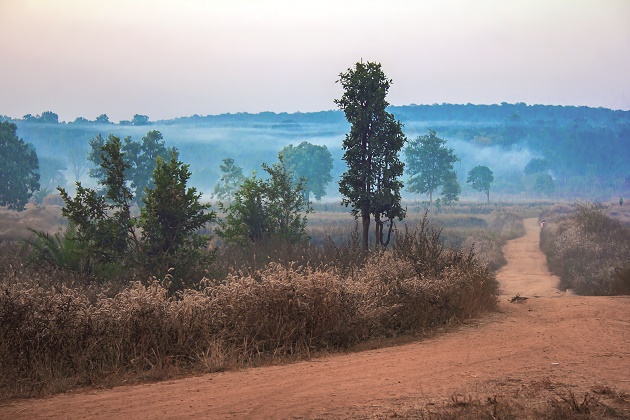
A picturesque valley at Jamgaon, where the author camped at former sarpanch Tulasi Majhi’s house.
We negotiated the steep Ghodadongar Ghat and its multiple, disconcerting hairpin bends, but the ride was well worth the trouble. And the view from the top was breathtaking. We eventually reached Jamgaon, where the former sarpanch, Tulasi Majhi, our host, was waiting for us. His home was my base camp for the next three days.
Exploring and Understanding Sunabeda
In the company of Tulasi and Tejraj, on the first day itself we made our way to the famous waterfalls of Beniadhus and Kharaldhus. There are no less than 12 waterfalls in Sunabeda and they are nothing short of magnificent in the monsoons. The Jonk river, which drains through the northern half of the forests, feeds some of these falls. The Sunabeda forests are typical of a central Indian landscape… but they seemed empty to me. I saw no signs of leopards or tigers… no scats, no alarm calls. As I quietly watched the sun set on the banks of the Jonk, I yearned for the honk of a sambar or the bark of a muntjac. Nothing!
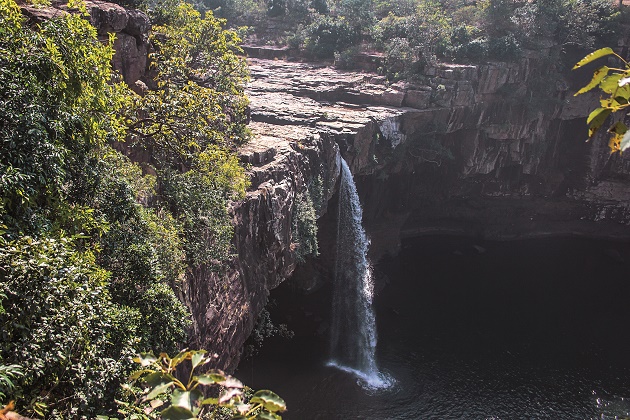
Sunabeda has no less than 12 waterfalls including the famous Beniadhus (seen here) and Kharaldhus, which are absolutely spectacular to behold in the monsoon.
It was cold and evenings were spent around a fire at Tulasi’s house, where the villagers would gather to share mahua (locally known as mahuli), an intoxicating brew distilled from the Madhuca longifolia flower. Using hand-made leaf cups, the hospitable villagers spoke of tiger sightings from years gone by. They do still see some leopards around their villages they said, but only very seldom did a tiger transit their forest from next door Udanti-Sitanadi.
Sitting with these simple folk, I learned of the lack of health facilities and their dependence on wholly unreliable medicine men. Also of the malnourishment suffered by children and the apathy of the district administration. NGOs that had worked here in the past had been of great help, but they moved out under threat from Maoists or perhaps because they ran out of funds.
There was marked distrust between the villagers and the Forest Department. Speaking openly, the villagers explained that they understood well the importance of the forests but were skeptical about the proposed tiger reserve and feared displacement. I did engage them and mentioned that there was no plan for relocation of villages but they were firm in their view because there were already obstacles in their path for collecting minor forest produce. A new conservation ethic is badly needed, one where locals actually benefit from enhanced biodiversity in Sunabeda. It’s not impossible, but it does require determination and honest efforts to better the lot of villagers in consultation with them.
A Lifetime of Neglect
The next day, we drove towards Datunama, the last post on the Odisha-Chhattisgarh border, hopeful that we might sight some wildlife. A heavy combing operation by armed forces was underway along the route to the village. The personnel were on foot, reinforcing the fact that driving on four wheelers through these forests can be dangerous. We reached a flat table top, a couple of miles before Datunama and decided to walk along a forest trail. Within a few steps, to our utter delight, we discovered a tiger scat. For the next couple of miles, enroute to Datunama, we came across multiple scats. This patch was possibly frequented by more than one tiger. The last census conducted by the Odisha Forest Department in 2016 estimated the presence of four tigers within the Khariar-Sunabeda forests. At the turn of the century there were around 30, but that figure does not seem to have been realistic.
The region is beset with trouble. In 2010, a Forest Department staff member was brutally murdered and subsequently, no full-fledged tiger census activities have been carried out across the Sunabeda landscape.

Sitting by the Jonk river, which drains through the northern half of the Sunabeda forests, the author yearned for the odd sign of wildlife presence.
I stood at the edge of a grassland, visualising what the scene could be if the forests were secured and protected over the next couple of years. Herds of chital would take over the table tops and bird song would return. But my reverie was short-lived as I saw a huge herd of cattle approaching. And we were in what was to be the core of the proposed tiger reserve! It seems cattle herders from as far as Madhya Pradesh enter inside. I learned that many such herders picked up money for poisoning tiger too.
This was hardly surprising, given the fact that patrolling was literally absent. The forest was an open vault for poachers, woodcutters and cattle grazers.
We arrived at Datunama, a hamlet occupied by few Paharia tribal families. They weave baskets and other bamboo products and move between different areas of the forest in search of suitable bamboo availability. The forest beat office was empty. Most of the forest posts in Sunabeda presented a similar scenario – broken, ruined or blown up. It was depressing to see the state of the Forest Department’s infrastructure. In many ways, it was representative of their shattered morale. The work of forest staff is now limited to peripheral activity such as road repair and weed clearing. Apart from a few symbolic conservation efforts, little is being done. Clearly community-based conservation work could make a world of difference, but nothing has been attempted. It is as if both people and the wilderness are caught in a time warp.
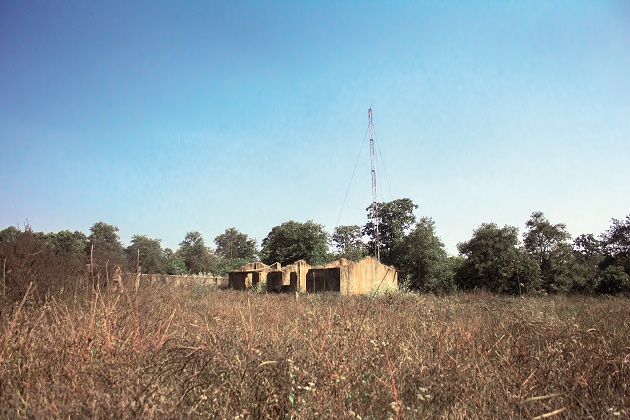
The forest office at Datunama has been abandoned owing to Maoist insurgency in the region.
Maneuvering the vehicle through the unrepaired forest road beyond Datunama was tough, and so we decided to walk across the border into Chhattisgarh. A group of villagers we met on the path mentioned tiger sightings. Earlier I had seen signs of nilgai. The forests of Khariar and Sunabeda are possibly the only areas in Odisha with a sizeable nilgai population and with strong protection measures the habitat can indeed be nurtured back to health so it is capable of supporting tigers.
I returned to Jamgaon with mixed feelings. I felt empty inside as if something was slipping out of our hands gradually and unceremoniously.
On our final day, we left before dawn to try our luck birding in some of the deeper forest pockets of Jamgaon.
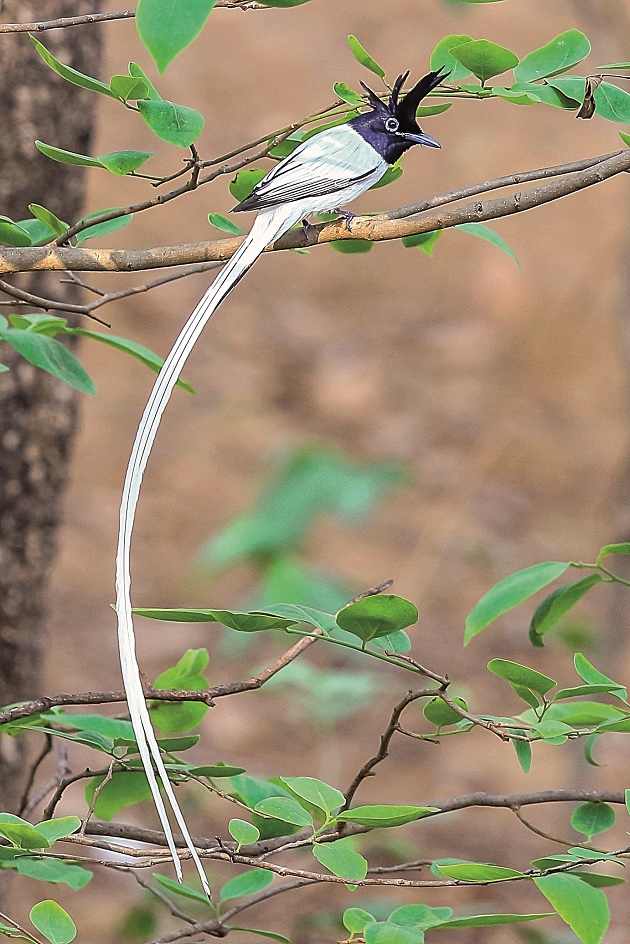
Indian Paradise Flycatcher.
The dried leaves on the forest floor were wet with dew. And in the silence of dawn, I could still hear the sound of dew drops falling on the forest floor. In the distance I heard the plaintive call of a Serpent-eagle, only to discover that I had been fooled by a Greater Racket-tailed Drongo mimicking the raptor.
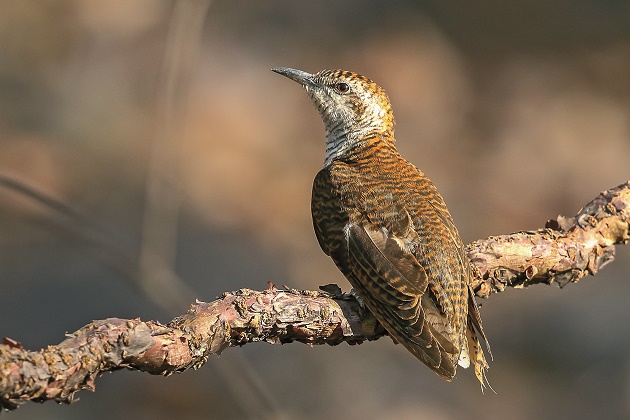
Banded Bay Cuckoo.
A group of Banded Bay Cuckoos chased each other above the canopy, while Brown-capped Pygmy Woodpeckers and a couple of Indian Nuthatches were busy plucking insects from tree barks. A flock of Yellow-footed Green Pigeons took off, only to be replaced by a lone Malabar Pied Hornbill.
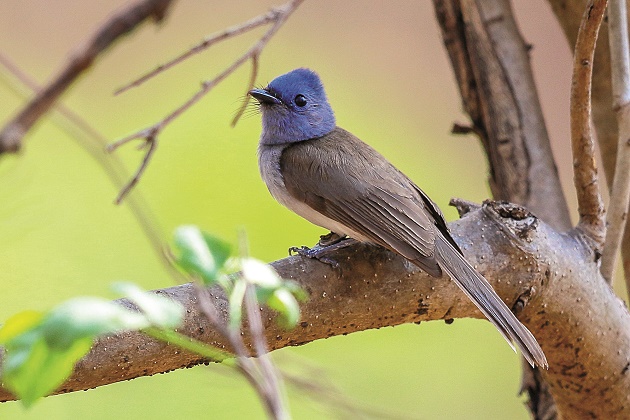
Black-naped Monarch.
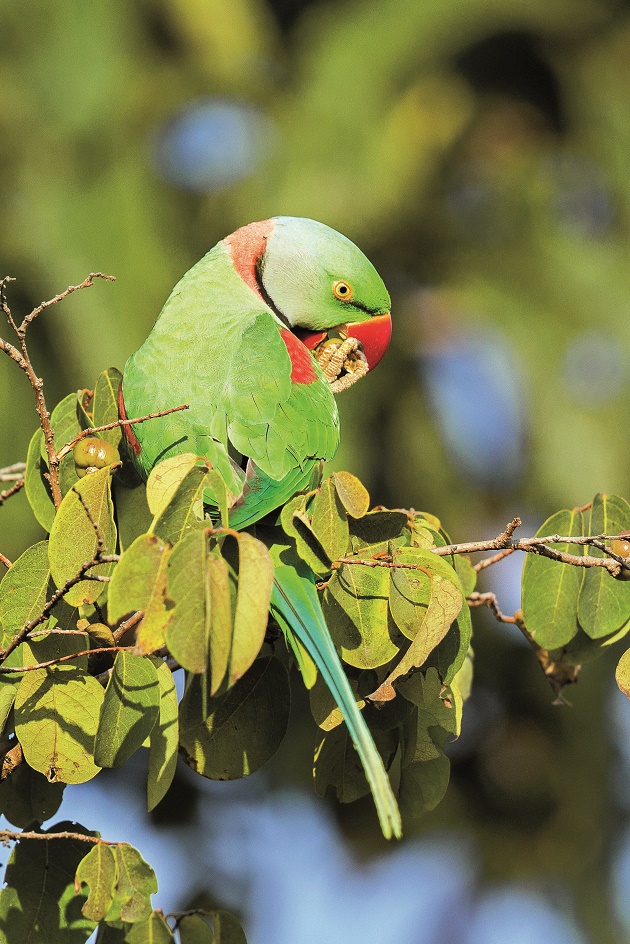
Alexandrine Parakeet.
To my delight, Tulasi spotted leopard pugmarks. At a nearby waterhole, barking deer hoof prints confirmed their presence. My hopes soared.
Sunabeda could still be saved.
In April 2018, The Corridor Foundation was launched by the author in Sunabeda, through which he aims to work with schools and villages to create awareness about the importance of protecting and nurturing forests and wildlife.
The Sanctuary Nature Foundation urges the government of Odisha to complete the tiger reserve notification process of the Sunabeda Wildlife Sanctuary and make conservation a top priority. Together with the Udanti-Sitanadi Tiger Reserve, this landscape forms a contiguous forest patch that has the potential to bring life back into this once-famous tiger forests. If we succeed, we would have saved more than just tigers. We would inject life back into the forests of Central India and enhance the water security of our people in the process.









